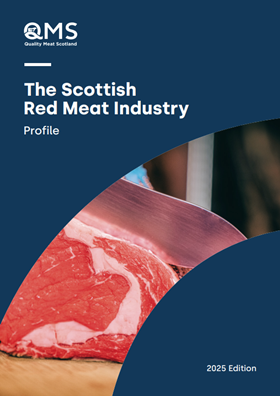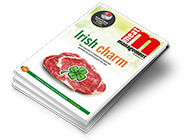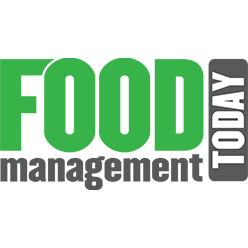Quality Meat Scotland (QMS) has underlined the socio-economic importance of Scotland’s red meat sector with the release of its latest Red Meat Industry Profile at the Turriff Show.

In a presentation to stakeholders at the Turriff Show on 4th August, QMS highlighted the importance of the sector in Scotland, stating that the Red Meat Industry Profile is a “key statistical tool supporting Scotland’s red meat and business decision makers”.
Consumer demand is strong
QMS said that the report shows that, on the surface, 2024 brought a “more settled year” for the supply chain, which included combined farming and processing output for cattle, sheep and pigs, estimated to have risen by 2% from 2023 and exceeding £2.7 billion. QMS stated that when economic ripple effects through the wider economy are considered, the sector’s total impact could have reached £3.5 billion of output and £1.05 billion of GVA in 2024.
The report spotlights continued strong consumer demand for beef, lamb and pork alongside the critical longer-term risk to both the economic and social contributions made by the sector from perpetual declining livestock numbers. Following on from the decline reported in June 2024, Scotland’s beef cow numbers were 3.6% lower than a year earlier in December 2024, leaving them down by 14.7% in the past decade. Calf registrations were down by 0.8% in 2024. There are now signs that the decline has slowed in the first half of 2025.
Falling for a third consecutive year, the ewe flock was down by 2.3% in June and QMS pointed out that these trends are “concerning to stability up and down the red meat supply chain” but noted that there is a clear opportunity for Scotland to fill demand if collection action is taken. This is highlighted in the QMS and Scottish Red Meat Industry Resilience Group’s Meating Our Potential campaign.
“We will continue to work closely with partners inside and outside of the red meat supply chain to keep Scottish beef, pork and lamb at the heart of our sustainable food system.”
Sarah Millar, QMS
QMS chief executive Sarah Millar commented: “With record high economic contribution in 2024, the latest data highlights that Scotland’s red meat sector remains a cornerstone of rural communities and a key contributor to the national economy.
“The evidence continues to reiterate demand for our renowned red meat is strong, with abattoir output rising 5% in 2024 to an estimated £1.14b. We know that there are underlying challenges in the farming sector impacting the critical issue of declining livestock, posing very real threats not only to our red meat sector but the wider economy, society and environment. We will continue to work closely with partners inside and outside of the red meat supply chain to keep Scottish beef, pork and lamb at the heart of our sustainable food system.”

Iain Macdonald, market intelligence manager at QMS and author of the 2025 Red Meat Industry Profile, said: “Despite record finished cattle prices and strong demand for both beef and lamb, the lack of profitability due to persistently high input and labour costs has driven further herd and flock reductions. Elevated interest rates made it costly to service existing loans and invest in the future, while the tight labour market continued to make recruitment difficult and wage costs high.”
QMS stated that turnover from primary red meat processing in Scotland rose for a fifth consecutive year in 2024, lifting 5% to £1.14 billion. While higher beef and lamb revenues offset marginal declines in pork revenue and hide values, rising livestock and production costs restricted improvements in processor margins. Employment in the processing sector fell, which is a reflection of both restructuring and productivity gains. A tight labour market saw the proportion of workers from non-EU/EEA countries overtake EU/EEA nationals.















